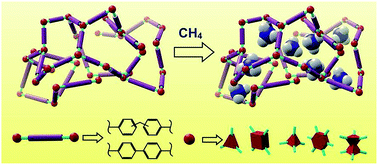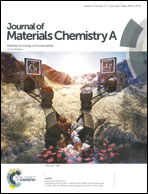Porous 3D polymers for high pressure methane storage and carbon dioxide capture†
Abstract
High surface area 3D polymers represent one of the most promising classes of porous materials because of their high gas uptake and stability to thermal and chemical degradation. A series of porous organic polymers with aromatic building units have been synthesized and compared to explore their high-pressure performance as adsorbents of gases of relevant importance for energy and the environment. Particular attention was paid to methane storage up to pressures as high as 180 bar at ambient temperature. Porous polymers were prepared starting from a wide choice of spatially expanded aromatic monomers: a systematic change in the number of rings, variable size and shape was taken under consideration. The high number of rings (up to 6), which act as multiple reactive sites and form a number of connections between the multi-dentate nodes, result in an extensive cross-linked framework. Condensation was obtained by two alternative synthetic routes, viz., Yamamoto cross-coupling and Friedel–Crafts alkylation reactions. The structural characteristics and high stability of the porous polymers, even to mechanical compression, were carefully determined by several methods, including 1D and 2D solid state NMR, FT IR and thermal analyses. The CH4 uptake in the porous polymers allowed an understanding of the incremental response to pressure, up to extremely high values, and the exploitation of the extensive pressure range to customize the gas adsorption/desorption cycles for storage and transportation. Owing to the notable presence of large mesopores and network flexibility, combined with high surface area, a remarkable gain at high pressure was achieved, ensuring a highly competitive uptake/delivery efficiency. At 180 bar, adsorption values up to 445 cm3 STP g−1 were measured for porous organic polymers such as carbazolyl- and triptycene-based materials. The benchmark of these materials PAF1 reaches the value of 916 cm3 STP g−1 of adsorbed CH4, exceeding the performance of most of the best performing MOFs, COFs and activated carbons. CO2 and N2 adsorption isotherms collected at room temperature enabled the assessment of the suitability of such polymer networks for CO2 selective separation and capture. In summary, the in-depth and extensive comparative screening within this class of materials up to high pressures provides the necessary parameters for further synthetic and applicative work.



 Please wait while we load your content...
Please wait while we load your content...